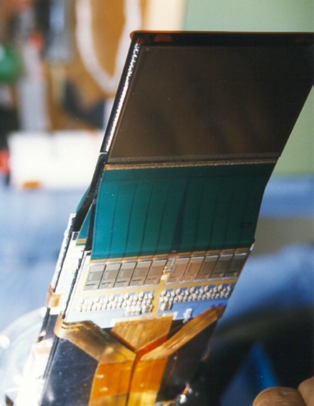ASIC laboratory Heidelberg
Content
- Welcome
- 10th Anniversary
- What's new?
- General
- Projects
- ALICE
- ATLAS
- DETNI Readout Chip
- DUNE Dust Telescope
- LHCb Beetle
- LHCb TDC
- Retina Scanner
- Vision
- Completed developments:
Chips in production or use - People
- Events
- Links
- Online public tutorials
- Publications
- Internals
- Sitemap
Completed developments: Chips currently in production or use
The H1 VLQ readout
Within the H1 experiment at the electron-proton storage ring HERA at the Deutsches Elektronen Synchrotron (DESY) in Hamburg an amplifier with very little noise was developed. The chip converts the weak charge signal of specially made photo diodes into a well measurable electronic tension. Each chip integrates 6 channels with a noise of 400 electrons at an integration time of 200ns. To obtain a very compact system, the produced chips were directly glued onto a printed circuit board and covered. The upper photography shows the uncovered but bonded chips. The complete system is in operation since may 1998. The test setup of this system is shown in the lower picture.
The H1 CIP read-out: CIPix
Within the upgrade program for the H1 detector at DESY a readout chip for the central inner proportional chamber (CIP) is developed. The chip amplifies and discriminates the weak charge signals of the central proportional chamber. To program the chip an I2C interface, which was developed in the laboratory, is used. First prototypes are already successfully tested.
A digital temperature compensated quartz oscillator: ADO
In GSM (Global System for Mobile Communication) and GPS (Global Positioning System) applications, precise and temperature stable quartzes are needed. In cooperation with a regional medium-sized enterprise a chip for temperature compensation of highly precise quartzes was developed at the ASIC laboratory. The chip measures the temperature of the system (chip, quartz and package) via an integrated sensor and from this data it computes indiviually for every quartz the necessary compensation function. A tension is derived from that and the quartz frequency is corrected. By this method temperature compensated quartz oscillators with a frequency accuracy of +-5ppm over a temperature range of 120 degrees celius can be realized. The picture shows such a highly precise oscillator in a package.
A fast transient recorder for a Cerenkov telescope: FASTSAMP
To detect cosmics particles in the earth atmosphere the Max-Planck-Institute for Nuclear Physics is developing a Cerenkov telescope. The Cerenkov light is amplified by multi anode photomultipliers. The ASIC laboratory is developing a CMOS chip that is amplifying and storing the fast signals of the photomultipliers.
Read-out electronics for microstrip elementary particle detectors at HERA-B: HELIX
Today, modern elementary particle physics experiments are confronted with the problem to process enormous amounts of data to detect the tiny effects that yet have a big impact on our overall picture of the universe. This problem is solved by using highly integrated microelectronics.

|
The ASIC laboratory at Heidelberg developed the HELIX pipelined read-out chip which amplifies the weak signals of so called micro-strip particle detectors. The chip can store them for some time before sending relevant data to the data acquistion system. A single chip reads out more than 100 channels, stores the signals for up to 12us before it sends the relevant data to the data acquisition system at a speed of 40MHz. The HERA-B experiment at DESY, Hamburg, reads out more than 300,000 data channels at a data rate of over 3TeraByte/s. Since detectors and chips are integrated into the smallest possible space, the chips are directly mounted on a carrier. The picture shows a silicon microstrip detector module, developed by MPI for nuclear physics at Heidelberg and MPI for physics at Munich. Two detectors can be read out on both sides and integrate together 4608 channels in a module of 10cm by 10cm. |
Besides HERA-B, the chip is also used by other experiments like ZEUS and HERMES.
Further information about the HELIX chip can be found here .
